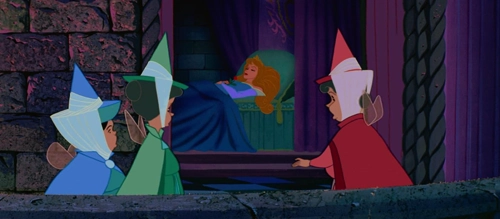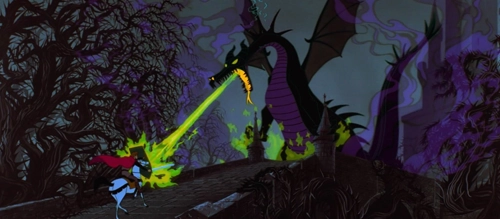‘Sleeping Beauty’ at 65 – Review

Sleeping Beauty (1959)
Directors: Clyde Geronimi, Eric Larson, Wolfgang Reitherman, Les Clark
Screenwriters: Erdman Penner, Joe Rinaldi, Winston Hibler, Bill Peet, Ted Sears, Ralph Wright, Milt Banta
Starring: Mary Costa, Bill Shirley, Eleanor Audley, Verna Felton, Barbara Luddy, Barbara Jo Allen, Taylor Holmes, Bill Thompson, Marvin Miller
In the world of animation, Disney films are typically lauded for their cultural impact and high standard of quality. In the 100 years since its establishment in 1923, the studio has won over 100 Academy Awards, Mickey Mouse has solidified himself as one of the most recognizable symbols globally, and the powerful corporation has subsumed Pixar and 20th Century, as well as the Marvel and Star Wars franchises. It is easy to forget that a lull in the studio’s output in the lead-up to founder Walt Disney’s death in 1966 led to box office bombs and poor critical reception. Sixty-five years ago, during the studio’s so-called Silver Age, Sleeping Beauty premiered in 1959 to a lacklustre response that laid the fairy-tale genre to rest until its revival in 1989 with The Little Mermaid. Often ignored in favour of the more popular Disney Renaissance films of the 1990s or Hollywood’s first full-length animated feature, the 1937 hit Snow White and the Seven Dwarfs, this drowsy princess’s story may not be one of the studio’s strongest releases, but offers more intrigue and beauty than meets the eye.
There have been many iterations of the ‘Sleeping Beauty’ tale passed down through generations of European storytellers before making it to Disney’s Burbank studios. The film owes its narrative to the 17th-century version recorded by French author Charles Perrault, whilst the score is inspired by Tchaikovsky’s ballet of the same name. The film pays homage to its fairy tale roots with an opening shot of an ornate tome titled ‘Sleeping Beauty’ as voiceover narration by Marvin Miller recites, “In a far away land long ago lived a king and his fair queen.” Slowly, the intricate page designs come to life as animated party-goers travel to a magnificent castle. Reminiscent of illuminations, colourful illustrations that scribes would include in hand-written manuscripts, the film owes its style to the narrative’s medieval European setting (the 14th century, to be exact). The animation technique thus makes the film unique in contrast to its predecessors by eschewing a more realistic look for a more stylized one, helping it stand out as one of Disney’s most visually striking releases.
The crowds arrive at the castle of King Stefan (Taylor Holmes) to celebrate the birth of the royal baby, Aurora. The new princess is betrothed to a young Prince Philip, who seems averse to the idea, and is then visited by three good fairies, Flora (Verna Felton), Fauna (Barbara Jo Allen), and Merryweather (Barbara Luddy). The first bestows the gift of beauty, the second grants her the gift of song, but before the third may announce her gift, the ceremony is interrupted by the entrance of Maleficent, ‘Mistress of All Evil’ (Eleanor Audley). Out of revenge for not being invited to the celebration, the wicked fairy curses Aurora with eternal sleep on the eve of her sixteenth birthday by the prick of her finger on the spindle of a spinning wheel. Though Merryweather cannot undo the curse, she adds a provision that true love’s kiss will be able to wake the sleeping princess. In an attempt to avoid the curse altogether, the three good fairies devise a plan to disguise Aurora as a peasant and raise her in a woodland cottage until she can safely return to the castle. Almost sixteen years in the future, it appears that Aurora (Mary Costa) has escaped Maleficent’s clutches but, in the eleventh hour, is lured to a spinning wheel and fulfills the curse. It is up to a grown-up Prince Philip (Bill Shirley) and the good fairies to save her from eternal slumber.
Not everyone has always been convinced by this story of love and lore. For instance, Shari Hirsch at Screen Rant criticizes the princess’s lack of depth, writing, “Aurora never becomes a fully developed character during her time on-screen.” A feminist critique of the film is fairly common with viewers frequently pointing out that the heroine barely speaks for the entire second half of the film. Furthermore, the only gifts that the good fairies bestow on her are beauty and song, flattening her character as naïve, two-dimensional, and not particularly bright. (Like many of her fellow Disney princesses, she sings about her desire for romance to an audience of woodland creatures and falls in love with a perfect stranger.) In contrast to her iconic predecessors, Snow White and Cinderella, and the tough-as-nails heroines that followed in her footsteps from Jasmine to Moana, Aurora is unfortunately a bit forgettable.
However, the princess is not the only female character in the film. In fact, between the three good fairies and Maleficent, Sleeping Beauty is a largely female-driven story that showcases different women with various skills, talents, and personalities. Flora is diligent and caring, Fauna is timid and well-intentioned, and Merryweather is sassy and helpful. Though all of them try and fail to bake a cake, sew a dress, and clean the cottage – household chores that would traditionally be classified as ‘women’s work’ – the three fairies complete these tasks by using their magical abilities to get the job done more efficiently. The fairies are also Aurora’s true saviours – Philip may wield the sword and offer true love’s kiss, but the three women rescue him from Maleficent’s dungeon, turn many of his dangerous obstacles into flowers and rainbows, and infuse his weapon with enough magic to defeat his enemy.

Then there is the evil fairy, one of Disney’s most complex and popular villains who received live-action treatment in Robert Stromberg’s 2014 film, Maleficent, starring Angelina Jolie in the titular role. In the animated original, she is elegant, clever, and formidable, always taking up space in the middle of the screen with bursts of flames, flowing robes, and a distinct purple, black, and green colour palette. In the truly thrilling, epic final battle sequence between Philip and Maleficent, she transforms dramatically into a towering, fire-breathing dragon. The prince may eventually vanquish the dragon (perhaps once again drawing inspiration from medieval heroes like Beowulf and St. George), but Maleficent endures as one of the most memorable parts of the film. The sharp dichotomy that the tale draws between good and evil may be reductive, but it is refreshing to see a real villain that the audience can love to hate in an age when Disney has not produced a compelling adversary in years.
Beyond these interesting female characters, the film is rather simple. It is full of Disney and fairy tale cliches from woodland animal friends to love at first sight and happily ever after. “Once Upon a Dream,” Aurora and Philip’s graceful duet, is a classic tune with a stunning performance by Mary Costa, who went on to become a renowned opera soprano, but unlike with many of the studio’s other releases, it is the only memorable song from the film. Originally screened in Technicolor, the animators took advantage of a striking, saturated colour palette, which is fully actualized when Flora and Merryweather alternately turn Aurora’s dress pink and blue as she and Philip share a final dance. And whilst many fans and critics alike have denounced Aurora’s unconscious true love’s kiss as unsettling at best and outright dangerous to younger viewers at worst, does it help that she had already fallen in love with him beforehand? Maybe not. That part did not age very well.
Sleeping Beauty may not have been one of Disney’s resounding successes in its day and it is often relegated to the side-lines of the studio’s history in favour of more classic, more contemporary, or more exciting films. Despite its relatively simplistic narrative and rather uninteresting heroine, however, the film deserves a rewatch on this anniversary for its intricate, medieval animation style and beautiful Tchaikovsky-inspired score, but perhaps most of all for its capable fairy protagonists and truly formidable, compelling villain.
Score: 18/24

